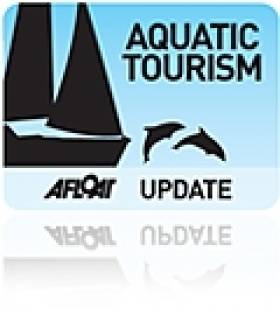Displaying items by tag: development
Coastwatch Warns Over Draining of Cork Wetlands
Ballyvergan marsh is under threat after the discovery of an illegal pipe being used to drain the wetlands area, claims Coastwatch.
The Irish Times reports that the environmental group has called for immediate action over the draining of the marsh near Youghal in Co Cork.
Cork County Council has also confirmed to the paper that a letter regarding an "allegation of unathorised development" has been sent to the landowner.
The marsh at Ballyvergan is one of the largest on the south coast, and is zoned as a special amenity. It is also an important breeding site for migratory birds.
Karin Dubsky of Coastwatch said that the situation highlights the deficiencies in State policy regarding Ireland's wetlands.
The Irish Times has more on the story HERE.
Ambitious Project Floated for Dun Laoghaire Harbour
Top British architects have won the commission to develop an ambitious master plan for Dun Laoghaire Harbour.
The Dun Laoghaire Gazette reports that Metropolitan Workshop have been tasked examining the feasibility of redeveloping the port to attract cruise liners carrying 100,000 passengers annually.
The plan, to be completed by the summer, is aimed at realising Dun Laoghaire's potential "as a major marine, leisure and tourism destination".
Improved public spaces linking the town and the harbour, tourism opportunities and new cultural attractions are just some of the proposals that the plan will take into consideration.
Jonny McKenna of Metropolitan Workshop old the Gazette: "Our approach is anchored in Dun Laoghaire's history and heritage. Our aim is to broaden the appeal of the harbour, both locally and internationally, as a world-class waterfront destination."
The consultation and drafting phase of the master plan will be completed by the end of this month.
Surfers Speak Out Over Doolin Point
Local surfers have expressed their dismay over the decision by Clare County Council to approve the new pier development at Doolin Point.
The Irish Surfing Association (ISA) maintains that even the revised plan - accepted by the council's 32 members following previous objections - would result in the destruction of the renowned waves at Doolin Point and Crab Island.
"I am very disappointed with this decision," Neil Cooney of West Coast Surf Club told Surfer Today. "A great deal of work was put into the West Coast Surf Club and ISA submission but it seems that the issues raised were ignored and brushed over."
He added: "If this development is built as now proposed it would be a catastrophe."
Conference Reveals State of Marine Leisure Industry
With boat sales falling by as much as 80%, marina business down 20%, retail sales in chandlery down up to 38%, insurance down 12.5% the marine industry in Ireland and Wales had to take some action to ensure the marine trade and leisure industry survives.
An unusual industry conference took place in Dun Laoghaire today and yesterday with the objective of understanding where the industry is right now and how it needs to act to ensure that it survives the downturn in our economies.
Over 125 marine businesses from both sides of the Irish Sea will be attending in what will be the largest marine leisure Industry gathering ever brought together.
A joint address was given by the Executive Director of the British Marine Federation, Howard Pridding and David O'Brien the Chairman of the Irish Marine Federation set the scene as to where the industry is on both sides of the Irish Sea.
The conference heard from 3 companies who operate in the sector. One from each region, North Wales, South Wales and Ireland who will share with the conference their experiences in the current economic climate on how they are surviving and thriving in the downturn. Business tactics that need to be deployed were explored with a leading business and innovation specialist from Wales together with joint talks by Visit Wales and Failte Ireland on the development of marine leisure tourism.
Leading economist Jim Power delivered a talk on the economic situation and when we might begin to see some consumer confidence return to our markets.
The Pembroke Coastal Forum told how they have managed their coastline and environment and how they have facilitated marine leisure tourism through proper marine spatial planning.
The conference is being organised by irish-sea.org and Ireland/Wales Interreg IV A Programme funded by the European Region Development Fund.
Irish-sea.org has three partners, North Wales Watersports, South West Wales Marine Federation and the Irish Marine Federation.
Greystones Harbour Hoardings Could Soon Come Down
The partially redeveloped Greystones Harbour could be opened to the public by mid-summer, The Irish Times reports.
Hoardings may come down to open the marine sections of the €300 million development while plans are finalised to complete the rest of the project - which includes new harbour marina facilities, commercial units, homes and recreational spaces.
A spokesperson for development consortium Sispar said the decision on finding the next phase rests with that National Assets Management Agency (Nama).
Wicklow County Council chairman Tom Fortune said he was hopeful that the hoardings around the harbour area would come down later this year “in part at least”.
The Irish Times has more on the story HERE.
New Marina Centre for Ballycastle
Work has begun on a new visitor services building at Ballycastle harbour as part of a £7.4 million (€8.6 million) marine tourism project for the nothern part of Ireland and western Scotland.
Moyle District Council is one of 20 partners involved in the Sail West Initiative to develop boating, angling and marine tourism related infrastructure along the Northern Ireland coast north of Belfast Lough, Counties Sligo and Donegal, and a large part of Scotland's west coast.
The plan will see the demolition of the existing bungalow at the harbour, to be replaced with a new state-of-the-art marina building and harbourmaster's office with shower, kitchen and laundry facilities.
The council will also take part in an extensive marketing campaign along with the other Sail West partners to promote the region as an important sailing destination for sea-faring tourists.
The Ballymoney Times has more on the story HERE.
Plans For Pontoon Berth Despite Block on Carlisle Pier Development
The Dun Laoghaire Harbour company has issued an invitation to tender for a new floating berth, despite being refused permission to continue development of the historic Carlisle Pier, The Sunday Business Post reports.
Most of the listed structure was torn down in September 2009 and replaced with a car park by the company, which said it received legal advice that planning permission was not required.
Following a campaign by local residents and the intervention of Green Party TD Ciarán Cuffe and Dun Laoughaire Rathdown County Council, An Bord Pleanála ruled that the redevelopment was not exempted.
According to The Sunday Tribune, the development plans were rejected on the basis of their effect on the local conservation area and failure to reuse elements of the old pier structures.
However, last week the company published a notice inviting tenders for a floating pontoon berth to be attached to the old pier, designed to accommodate cruise passengers.
The tender details are available to read online, and the project is currently pending planning permission.
The harbour company is part of the Dun Laoghaire Cruise Stakeholder Group, which is marketing the town as a destination for international cruise liners.
Public Views Galway Harbour Plans This Weekend
Plans for the development of Galway Harbour are open for public consultation this weekend, The Irish Times reports.
The Galway Harbour Company's €200 million scheme involves moving the port south onto 24 hectares of reclaimed land in deeper water to accommodate cruise liners.
A new rail link is also proposed, as well as an expanded marina with more than 200 berths.
The company's chief excecutive Eamon Bradshaw said the first stage of the plan would be self-financed, but did not rule out the possibility of EU funding, public-private partnerships and private investment.
Pending planning approval, development is hoped to begin at the end of 2012 - some months after Galway welcomes the return of the Volvo Ocean Race.
Thr Irish Times has more on the story HERE.
South-East's Coast, Rivers Hold Tourism Potential
Tourist anglers spent €89.9 million in Ireland in 2008, a marine leisure conference in Co Waterford heard recently.
The importance of angling to the economy was highlighted at the Rising Tide seminar in New Ross, an event focused on developing historical connections between Ireland and Newfoundland in Canada in the areas of fisheries, development and coastal tourism.
Speakers noted the "strong maritime tradition" along the south-east coast, the potential of the Waterford Estuary as a gateway to the region's inland waterways, and opportunities for development to tie in with next year's visit of the Tall Ships.
Minister of State for Fisheries, Sean Connick TD, also announced funding of €156,000 for Wexford harbours in tandem with Wexford County Council's allocation of €52,000.
The Irish Times has more on the story HERE.
Surfers Stand Strong on Doolin Point
Irish surfers have won their first battle against the development of Doolin Point in Co Clare, site of one of the country's top wave spots.
A planned council vote on proposals for the €6 million Doolin Pier development was halted last week after concerns were raised by the surfing community both at home and abroad, Surfer Today reports.
The council intends to lodge a new planning application for a smaller development 25 metres further away from the shore that is intended to have less impact on surfing conditions. A public consultation on the proposed development has also been suggested.
"It is vital that we do not lose the €6 million in funding, but we also have to make sure that the integrity of the waves are protected," said Councilor Martin Conway.
Doolin Point is considered one of the top wave spots in Europe, with significant tourism potential for the Irish economy.






































































